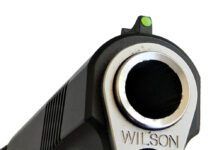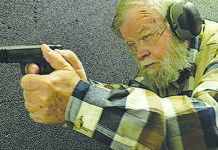After two solid hours’ disgusting labor removing all the packing grease (we hesitate to call it Cosmoline) from all the parts and wood, which required complete disassembly of the greased-up rifle, we found we had an attractive rifle on our hands. The bore was pristine. The wood was attractive, orange-hued hardwood (we suspect it was European walnut) that carried an honest dent and gouge here and there, but not so many as to be disastrous. The metal was well blued, not Parkerized, though the metal appeared to have been rebuffed, presumably an arsenal refinish. Many of the rifle’s parts bore five-digit numbers, and they all matched.
The trigger pull was as fine as we’ve seen on a military rifle, much better than on many a commercial firearm. The safety, that bit of curved steel to the right of the trigger within the trigger guard, worked easily and positively. We can’t help but notice the similarity of this safety’s motion to that of the commonly seen (later) M1 Carbine safety. Both can be easily manipulated by a right-handed shooter with his trigger finger, and both can result in the finger’s rapid placement onto the trigger, which can easily fire the piece when you’re not ready for it.
Like all SKS’s this one had a ten-round attached magazine that can be filled with stripper clips, or by individually inserted rounds. The contents of the magazine can be dumped by pulling rearward on a tab located in front of the trigger guard, just behind the mag box. We have long thought the combat drill for these weapons would be to shoot as many rounds as needed. Then, in any lull in firefight activities when it’s time to reload, the shooter could either a) dump the magazine’s contents, close the magazine, eject the chambered round (thereby locking the bolt back), and recharge ten rounds via stripper clips; or b) surrender. There is no easy way to lock the bolt back with rounds in the magazine. Therefore, if you’ve fired six or seven shots, leaving one in the chamber and two or three in the mag, there’s no quick way to fully charge the rifle. As we are taught at modern gunfighting schools, it is mandatory to reload the firearm fully at every opportunity, and proper training includes learning this drill. With a modern firearm’s detachable magazine, it doesn’t take long at all to reload.
The SKS operates by bleeding gas off through a hole in top of the barrel. The gas then drives a pushrod rearward, which strikes another pushrod (contained beneath the rear sight), which drives the two-piece bolt back against its mainspring. The bolt carrier moves first, and as it moved rearward it releases the main bolt and then lifts it out of its recess in the action, and the two then move rearward to eject and reload in the normal manner.
Takedown is easily accomplished by turning a lever on the rear of the action and pulling it out while simultaneously pressing forward on the rearmost part of the action, on what is actually the bolt-spring cover. With the pin out of the way, the cover slides off the gun rearward, and then the bolt spring and bolt can be removed. The barrel can be cleaned from the breech. Further disassembly is seldom needed, but the two gas pushrods may be easily removed by rotating a lever on the side of the rear sight. This permits removal of the upper hand guard and then the stiffly sprung pushrod within the sight base.
The action may be removed from the wood by pressing smartly inward on a plunger at the rear of the trigger guard, which releases the trigger assembly to be lifted out of the wood. The magazine may be then removed, and the action may be pulled from the stock. The only tricky part of reassembly is to make sure the magazine front is in the correct position, hooked over a cross pin within the action, before installing the trigger guard assembly.
The rifle’s sights were simple, giving a post front and U-notch rear as seen by the shooter. The rear was ramp-adjustable for elevation, with battle markings out to 1,000 yards. Although aftermarket scope mounts exist that replace the bolt-spring cover, we used the existing iron sights for our shooting evaluation, with the sights set to their lowest position. The impact turned out to be too high on both rifles, about 7 to 8 inches above point of aim at 50 yards. The front sights would have to be raised (turned) to get a low-enough hit for most shooters, and you may need a special tool for that task. These tools used to be common at gun shows, and your local gunsmith may have one.
We fired the rifles with two types of ammunition, one of which was military-like Russian ammunition, but having a hollow point. The other was a soft-nose version manufactured in China. At the range, we found the Albanian rifle to be perfectly reliable. Despite the good trigger, accuracy was about average, the best group being 1.5 inches at 50 yards, and the worst about 4 inches. There were no problems with the rifle whatsoever.




























